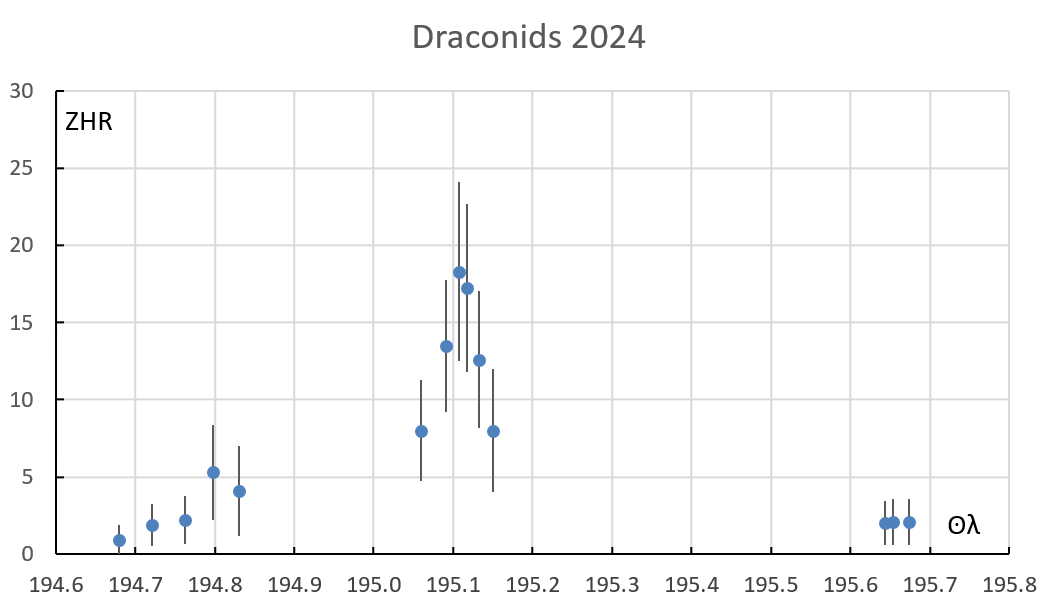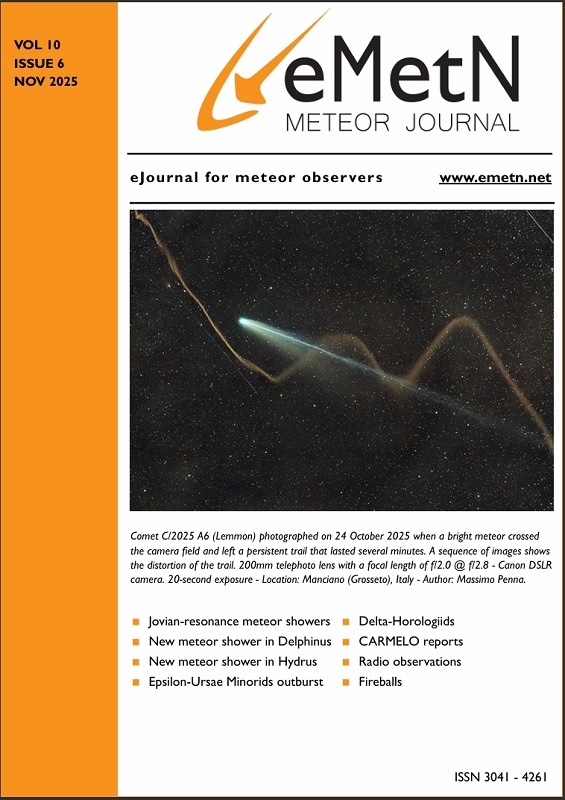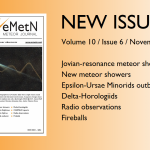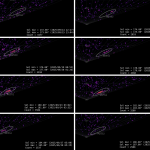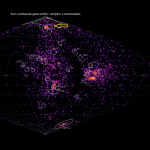Introduction
The Draconids are well-known from the large meteor storms of 1933 and 1946. The Draconid storm from 1933 was observed by the author’s father-in-law (Dirk Teunissen) on his way home from school between Harderwijk and Ermelo. The meteorshower has since shown regular outbursts with ZHR values between 20 and 700. The last outbursts were in 2011 (Langbroek, 2011 and Miskotte, 2012) and (Vandeputte, 2018); (Miskotte, 2018); (Miskotte, 2019). The one from 2011 showed multiple peaks that could be linked to a number of dust trails [Miskotte, 2012). In 2018 there was more of a “capped” peak or plateau with the ZHR fluctuating around 150 for a number of hours [Miskotte, 2019). All these outbursts were related to the perihelion of the parent body of the Draconids, the comet 21P/Giacobini-Zinner. Next year on March 25, this comet will be in perihelion again. The annual activity of the Draconids is not very significant, both visual observers and the video networks hardly see any Draconids then.
This year some extra activity was expected on October 8 caused by two dust trails of 21P/Giacobini-Zinner from 1852 and 1859. Both Peter Jenniskens and Jéremy Vaubaillon predicted times on October 8, 2024 roughly between 6 and 7 UT (Rendtel e.a. 2024). Because these were old dust trails, both astronomers did not make a prediction for the expected ZHR values.
Draconid outburst?
As early as October 8 during the day, Pierre Martin from Canada reported his experiences to the author via messenger:
“This past night October 7/8, I was out observing from late evening until early morning and not only saw a bright and stunning Aurora display, but also some decent Draconids activity! A minor outburst of low level activity occurred with a few members visible every hour. It was easily the more active meteor source during the night. It is the most Draconids that I’ve seen in one night after the 2018 outburst. I did not observe a noticeable enhancement around the times that Jenniskens and Vaubaillon predicted the old dust trails but by then the radiant was very low. My observations were also quite “affected” by a brilliant aurora display, forcing me at times to meteor observe closer to the zenith or towards the western sky.”
On October 12, the Draconid outburst observed by the Global Meteor Network was reported in CBET 5456 by D. Vida, A. Egal, P. Brown, and M. Campbell-Brown, University of Western Ontario; and W. Cooke and D. Moser, Meteoroid Environment Office, NASA (Vida, 2024). The outburst peaked with a ZHR of 15.7 +/- 1.4 at solar longitude 195.08 +/- 0.05 degrees (October 8, 2024 at 05h15m UT +/- 1 hour). The ZHR was calculated assuming a mass index of s = 2.0 and a population index R = 2.5. The total period of enhanced activity lasted about 10 hours. How to calculate the ZHR and flux from video data is published in (Vida et al, 2022). The well-known CMOR meteor radar also recorded this faint peak around solar longitude 195.133 +/- 0.04 degrees. Preliminary modeling suggests that the outburst may have been caused by a dust trail ejected by comet 21P/Giacobini-Zinner in 1900.
The CAMS network has also clearly recorded more Draconids than normal.
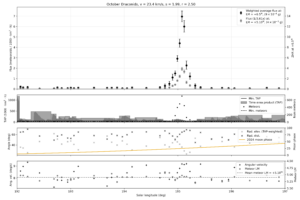
Figure 1. ZHR and Draconid flux between Ꙩλ = 192-197. Source: https://globalmeteornetwork.org/
Visual observations
As written, Pierre Martin reported all his experiences to the author. A few weeks later, all Draconid data uploaded to the IMO website was retrieved. In total, 7 observers observed the Draconids. These were Pierre Martin (Canada), Jürgen Rendtel (Germany), Ina Rendtel (Spain), William Godley (Oklahoma, US), Ivan Sergey (Belarus), Wesley Stone (Oregon, US) and the author (the Netherlands). Some observers made the following comments:
“Saw a Draconid shoot from N to S while out letting our pup do his business, so sat out for 30 minutes in case something special might be happening. A couple more made a showing, but nothing dramatic so tiredness and work the next day called me back into the house. William Godley”.
“I got a bit of a late start as there was a decent auroral display early on. By the time I started counting, the aurora had settled down to a diffuse red glow in the northeast. Draconids were prominent and bright, especially early. Poor horizon elevation and aurora to the east, so I centered my view to the northwest and west, forsaking any shower associations of Delta Aurigids or early Orionids. Wesley Stone”.
In total, all these observers counted 65 Draconids. And taking into account that part of the data was obtained with low radiant angles below 25 degrees, this makes it a rather difficult analysis. To illustrate this, figure 2 shows all individual ZHR values of all Draconid observations. Only for the period of October 8, 2024 between 03:45 and 07:45 UT, the population index R was determined based on 52 Draconids: r[0:5] 2.36 ~0.32 (Steyaert, 1981). For the period outside this period, a population index r of 2.50 was used. The ZHR formula used is:

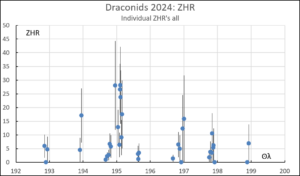
Figure 2. All individual ZHRs of all observers. It is remarkable that also a few days before and after the maximum ZHR values between 2 and 10 are found. This concerns
mostly observations at very low radiant position where for example 1 Draconid in an hour produces a ZHR of 5 or more. This graph therefore says little about the activity itself.
Note: this ZHR values are not been corrected for zenith attraction.
In large analyses where a lot of data is processed, certain requirements are imposed on the data. These requirements are:
- Reliable Cp determination
- Minimum limiting magnitude rounded off 5.9.
- A minimum radiant height of rounded off 25 degrees.
The problem is that if we apply these rules to the few observations of the Draconids 2024, there is far too little data left to calculate with. That is why the standard requirements were adjusted so that more data remained to analize.
- The minimum radiant heights between 7 October 19 UT and 8 October 8 UT are set at 10 degrees. Minimum radiant heights before and after the aforementioned period are 20 degrees.
- If known, the Cp was included in the calculations, otherwise Cp 1.0 was used.
- Limiting magnitude at least 5.5.
In the case of overlapping periods, the ZHR was determined using a weighted average. Because the Draconids have a very low geocentric velocity and the observations were often performed at low radiant positions, zenith attraction was taken into account in the ZHR calculations. Zenith attraction is an effect that mainly occurs with slow meteors. Due to the gravitational pull of the earth, the direction and speed at which the meteor approaches the earth changes. This also changes the position of the radiant, which then becomes somewhat higher. See also figure 3 (Rendtel, 2022&2024). Therefore, corrections were made for the zenith attraction for all radiant heights (Rendtel, 2022&2024). This results in a considerable difference in outcome, especially for the observations of Pierre Martin who observed with very low radiant positions. The result are figures 4 and 5, which show clear differences in outcome.
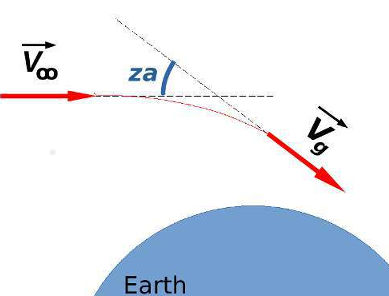
Figure 3. Zenith attraction (angle za) of the radiant of a meteor approaching the Earth with velocity v∞; the velocity vector changes in direction and magnitude in vg.
Figure is taken from (Rendtel, 2022&2024).
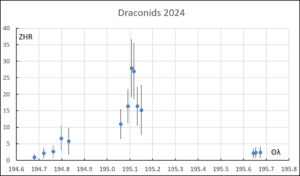
Figure 4. The ZHR curve based on 5 observers, not corrected for zenith attraction. A maximum ZHR of 28 around solar longitude 195.1.
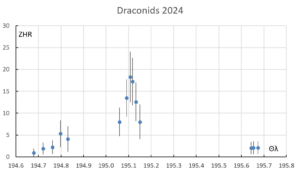
Figure 5. The final ZHR curve where radiant positions are corrected for zenith attraction. This of course results in lower ZHR values due to the higher radiant heights.
The small Draconid outburst based on observations by Pierre Martin and Wesley Stone with a peak around Ꙩλ = 191.12 ̊ and a maximum ZHR of 18 ± 6 nicely matches the values found by the CMOR radar and the GMN video network. This also gives more confidence in the adjusted procedure followed. The individual ZHR values found between Pierre Martin and Wesley Stone also match well, especially after correcting for zenith attraction.
Also striking is the ascending curve between λꙨ = 194.6 and 194.9. These are observations by Ina Rendtel who observed for 5 hours from northern Spain in the evening of October 7th under pitch-dark conditions (limiting magnitude 6.8). This seems to be a nice run-up to the somewhat larger activity observed by Pierre Martin and Wesley Stone around λꙨ = 195.1. The ZHR of 2 in the evening of October 8th is based on data from Ivan Sergey and the author. The fact that these two observers clearly saw low activity means that the increased activity may have lasted for 24 hours.
In summary
All in all, the result is not disappointing considering the small amount of data and the low radiant heights. The maximum time and maximum ZHR found correspond nicely with maximum times and ZHR values found by CMOR and GMN (GMN). This also gives confidence in the modified method used for this dataset.
Acknowledgements
A word of thanks to all observers mentioned in this article who observed the Draconids in 2024. And a big thank you to Pierre Martin for checking my English!
References
Langbroek M., et al (2011), Draconiden 2011 vanuit Dunkelsdorf en Kühlungsborn (noord Duitsland): visueel, met video en LiDAR, eRadiant 2012-1, p. 5-12.
Miskotte K. (2012), Draconiden uitbarsting waargenomen, een eerste analyse, eRadiant 2012-3, p. 69-74.
Miskotte K. (2018), Draconiden uitbarsting 8/9 oktober 2018!, eRadiant 2018-4, p. 125-126.
Miskotte K. (2019), The outburst of the Draconid meteor shower in 2018: an analysis, eMeteornews 2019-2, p. 74-78.
Rendtel J., et al (2024), 2024 Meteor Shower Calendar, IMO.
Steyeart C. (1981), Populatie indexbepaling : methode en nauwkeurigheid, Technische Nota nr. 5 VVS Werkgroep Meteoren, september 1981.
Rendtel J. (2022-2024), Handbook for Meteor Observers, Chapter 7.3.3 The zenith correction factor, p. 140-143.
Vandeputte M. (2018), Draconiden uitbarsting!, eRadiant 2018-4, p. 127.
Vida D., et al (2022), Computing optical meteor flux using global meteor network data, Monthly Notices of the Royal Astronomical Society, Volume 515, Issue 2, September 2022, P. 2322–2339.
Vida D., et al (2024), 2024 Draconid Meteor Outburst, CBET 5456, Editor: Daniel W.E. Green

